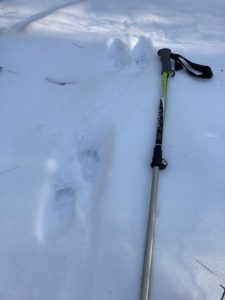Shy Neighbors Leave Tracks and Need Our Help
By Cathie Murray
In Bow, neighbors help each other out, and find ways to celebrate together – like a fire pit during Covid times. But have you noticed some neighbors avoiding you? They wait until dark to come out, and even then they keep to the treelines and the shadows, or crawl under snow, leaves or the earth.
These shy neighbors are wild, furry, four-footed creatures. Most travel and forage for food at night. Besides avoiding us and our pets, the smaller animals use night to reduce their chances of being eaten. Since the predators have to show up where and when the smaller animals are, night-time is where the action is.
Seed eaters! Grub eaters! Twig and bark eaters! Big critters that eat little critters! Big critters that eat frozen apples!
A few of the shy creatures who call Bow home in the winter are: White-footed Mouse, Deermouse, Star-nosed Mole, Meadow Vole, Masked Shrew, Snowshoe Hare, Porcupine, Striped Skunk, Opossum, Raccoon, Gray Fox, Red Fox, Eastern Coyote, Bobcat, Weasel, Mink, Fisher, Otter, and White-tailed Deer.

Tracks of a Fisher
Want to know them better? Head outside the day after a snowstorm. A fresh coat of snow on a firm base is best, but look for tracks in your yard, local fields or woods after any snowstorm. Tracks will tell you stories.
Stand back at first. Do you see a pattern of paw prints?
Almost a straight line? Fox, coyote, cats, bobcats and deer often walk this way, putting their hind foot where their front foot was.
Does it look like a bounder, with pairs of prints spaced almost the same distance apart? Meadow voles are very tiny bounders. Bigger ones might be a weasel, mink or fisher.
Is the pattern wide and irregular, almost like a waddle? This might be a skunk, raccoon, porcupine, or opossum.
Or does it look like a hopper, with a pair of small prints and bigger prints bunched together? Squirrels do this. They plant their small forefeet and bring the larger hind feet around and in front of them. If the prints are very small they are shrews or mice. Snowshoe hares are hoppers too, but have large hind feet to support them on the snow and often plant their front feet one in front of the other.
To get a specific ID you will have to do more detective work, counting toes, checking for claws, measuring the stride and straddle. There are plenty of resources for you online or at the library. (NH Fish and Game has a handy pocket guide for tracks, posted here.)
These critters have lived here for thousands of years but our current way of life is hard on them.
What do they need from us? Clean water in streams and ponds. Diverse native plants for food. No poisons, so insects and other small animals survive to feed the bigger animals. Shrubs along streams, corridors of trees and roadless areas for safe travel and shelter. “Dark sky” lighting is safe for us and safer for wildlife.
Making your yard critter friendly is a great start. But since the territory of a tiny deermouse can be 3000 square meters, it will take our whole town to keep wildlife welcome and safe!
Cathie Murray is a Maine Master Naturalist who occasionally visits and walks the woods of Bow. A version of this article was also published in the Hallowell Champion.




